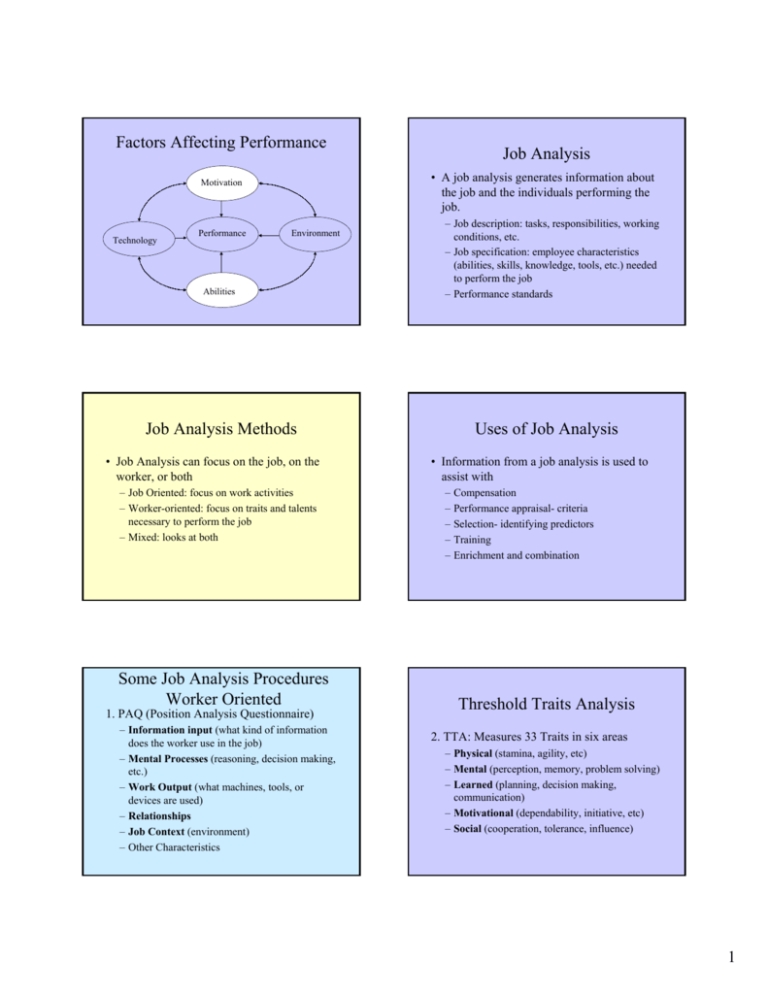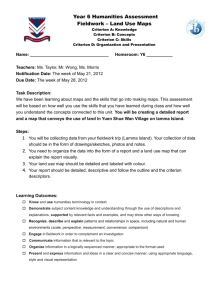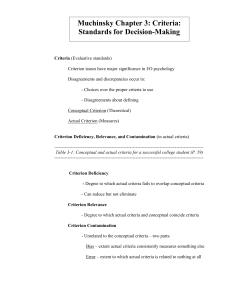Factors Affecting Performance Job Analysis Job Analysis Methods
advertisement

Factors Affecting Performance • A job analysis generates information about the job and the individuals performing the job. Motivation Technology Performance Job Analysis Environment Abilities – Job description: tasks, responsibilities, working conditions, etc. – Job specification: employee characteristics (abilities, skills, knowledge, tools, etc.) needed to perform the job – Performance standards Job Analysis Methods • Job Analysis can focus on the job, on the worker, or both – Job Oriented: focus on work activities – Worker-oriented: focus on traits and talents necessary to perform the job – Mixed: looks at both Some Job Analysis Procedures Worker Oriented 1. PAQ (Position Analysis Questionnaire) – Information input (what kind of information does the worker use in the job) – Mental Processes (reasoning, decision making, etc.) – Work Output (what machines, tools, or devices are used) – Relationships – Job Context (environment) – Other Characteristics Uses of Job Analysis • Information from a job analysis is used to assist with – – – – – Compensation Performance appraisal- criteria Selection- identifying predictors Training Enrichment and combination Threshold Traits Analysis 2. TTA: Measures 33 Traits in six areas – Physical (stamina, agility, etc) – Mental (perception, memory, problem solving) – Learned (planning, decision making, communication) – Motivational (dependability, initiative, etc) – Social (cooperation, tolerance, influence) 1 Other Job Analysis Methods Occupational Information Network (O*NET) U.S. Dept. of Labor • O*NET – Worker Requirements (Basic skills, Knowledge, education) – Worker Characteristics (abilities, values, interests) – Occupational Characteristics (labor market information) – Occupation-Specific Requirements (tasks, duties, occupational knowledge) – Occupational Requirements (Work context, organizational context) • CIT- (Critical incidents technique) collects and categorizes critical incidents that are critical in performing the job. • Task Oriented Procedures 1. Task Analysis- compiles and categorizes a list of task that are performed in the job. 2. Functional Job Analysis (method)– describes the content of the job in terms of things, data, and people. O*NET Basic Skills • • • • • • • Reading Active listening Writing Speaking Critical thinking Repairing Visioning Conceptual versus Actual • Conceptual Criterion– the theoretical construct that we would like to measure. • Actual Criterion– the operational definition (of the theoretical construct) that we end up measuring. Issues to Consider in Developing Criteria for Performance • • • • • Long term or short term performance Quality or quantity Individual or team performance Situational effects Multidimensional nature of performance at work • What do we want to foster? Cooperation or competition, or both? Criterion Deficiency Criterion Deficiency Conceptual Criterion Relevance Criterion Contamination Actual Criterion We want the conceptual criterion and actual criterion to overlap as much as possible. 2 Types of Performance Criterion Deficiency • Criterion Deficiency– the degree to which the actual criterion fails to overlap with the conceptual criterion. • Criterion Relevance– the degree of overlap or similarity between the actual and conceptual criterion. • Contamination– the part of the actual criterion that is unrelated to the conceptual criterion. • Task Performance– generally affected by cognitive abilities, skills, knowledge & experience. • Contextual Performance– generally affected by personality traits and values includes helping others, endorsing organizational objectives, & contributing to the organizational climate. Prosocial behavior that facilitates work in the organization. • Adaptive Performance– engage in new learning, coping with change, & developing new processes. Criteria Used by Industry to Validate Predictors Criteria • Criteria Should be – Relevant to the specific task – Free from contamination (does not include other factors relevant to task performance) – Not deficient (must not leave out factors relevant to the performance of the task) – Reliable • • • • • • • • • Supervisory performance ratings Turnover Productivity Status Change (e.g. promotions) Wages Sales Work samples (Assessment Centers) Absenteeism Accidents Personnel Psy, by Schmitt, Gooding,Noe, & Kirsh (1984) Predictor No. of Studies Average Validity Special attitudes 31 .27 Personality 62 .15 General mental Ability 53 .25 Biodata 99 .24 Work samples 18 .38 Assessment Centers 21 .41 Physical Ability 22 .32 Overall 337 .28 Reliability • Classical Model – An observation is viewed as the sum of two latent components: the true value of the trait plus an error, • X= t + e • The error and the true component are independent of each other. • The true and error component can’t be observed. 3 Test-Retest Reliability Types of Reliability Test-retest reliability Alternate-form reliability Split-half reliability Internal consistency (a.k.a., Kuder-Richardson reliability; a.k.a., Coefficient Alpha) Test-retest reliability is estimated by comparing respondents’ scores on two administrations of a test Test-retest reliability is used to assess the temporal stability of a measure; that is, how consistent respondents’ scores are across time The higher the reliability, the less susceptible the scores are to the random daily changes in the condition of the test takers or of the testing environment The longer the time interval between administrations, the lower the test-retest reliability will be ¾ The concept of test-retest reliability is generally restricted to short-range random changes (the time interval is usually a few weeks) that characterize the test performance itself rather than the entire behavior domain that is being tested ¾ Long-range (i.e., several years) time intervals are typically couched in terms of predictability rather than reliability ¾ Test-retest reliability is NOT appropriate for constructs that tend to fluctuate on an hourly, daily, or even weekly basis (e.g., mood) Interrater reliability (a.k.a., interscorer reliability) 19 Reliability • How consistent is a measure over repeated applications. • Consistency is a factor of the error in the measure. • If we view an observation as X=T+E, we can define reliability as the ratio of two variances. Job Analysis of the Student Development • Cognitive skills– Analysis, innovation, ability to learn • People skills– Cooperation, conflict resolution, & emotion intelligence • Communication– Written and verbal communication skills • Motivation and commitment 20 Signal to Noise • Under the assumption of independence, we define reliability as σ t2 ρ= 2 σ t + σ e2 Sources of Unreliability • Item sampling • Guessing • Intending to choose one answer but marking another one • Misreading a question • Fatigue factors 4 Methods of Estimating Reliability Problems With Reliability • Test-retest • Parallel (alternate) -forms • Split-half (must use adjustment SpearmanBrown) • Kuder-Richardson (Alpha) • Inter-rater • Homogenous groups have lower reliability than heterogeneous groups • The longer the test the higher the reliability • Most reliability estimates require that the test be one-dimensional Establishing Validity Validity • Content validity– The degree to which the items in a test are representative sample of the domain of knowledge the test purports to measure • 1. Whether a test is an adequate measure of the characteristics it is suppose to measure. • 2. Whether inferences and actions based on the test scores are appropriate. • Similar to reliability, validity is not an inherent property of a test. • Criterion Related Validities– the degree to which a test is statistically related to a performance criterion. – Concurrent Validation – Predictive Validation • Construct Validity– the degree to which a test is an accurate measure of the theoretical construct it purports to measure. – Multi-trait Multi-method approach Good Reliability, Poor Validity Poor Reliability, Poor Validity 29 30 5 Performance Appraisal Goals Good Reliability, Good Validity • • • • • Assessment of work performance Identification areas that need improvement Accomplishing organizational goals Pay raises Promotions 31 Potential Problems • Single criterion- most jobs require more than one criterion • Leniency- inflated evaluations • Halo- one trait influences the entire evaluation • Similarity effects- we like people like us • Low differentiation- no variability • Forcing information- making our minds too soon. Methods of Performance Appraisals • Basic Rating Forms – – – – – – Graphic forms BARS (Behaviorally anchored ratings scales) BOS (Behavioral observation scales) Check lists (based on ratings of CI) Mixed scales 360 degree feedback • None have shown overall advantage Possible Solutions • • • • • Use of multiple criteria Focusing on behaviors Using multiple evaluators Forcing a distribution Important Issues: – Training the evaluators – Rater’s motivation Assessments • Supervisor’s assessment • Self-assessment– generally people recognize their own strengths and weakness, but they are generally a bit inflated. • Peer assessment– very accurate in predicting career advancement. 6 Performance Appraisals • PA systems that have failed in court generally were – Developed without the benefit of a Job Analysis – Conducted in the absence of specific instructions to raters – Trait oriented rather than behavior oriented – Did not include a review of the appraisal with the employee 7








